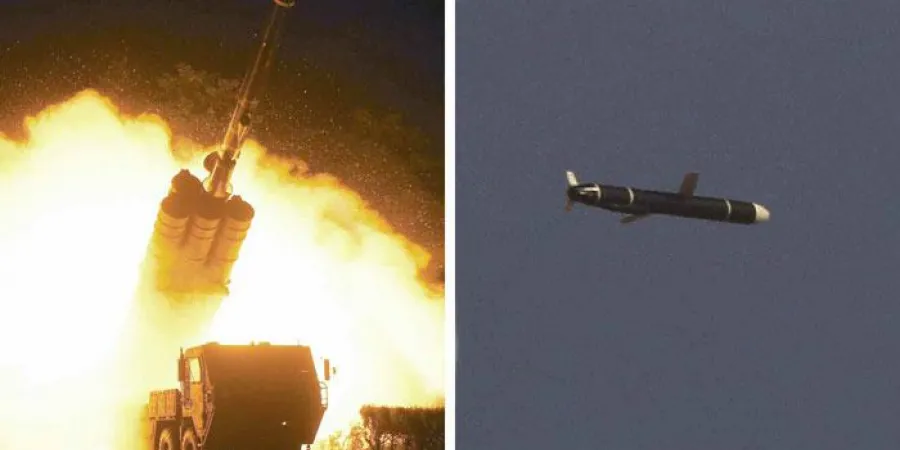Commentary: Despite sanctions, N. Korea continues to develop its missile capabilities
Pyongyang recently provided the latest proof that financial sanctions do not stop rogue states from developing weaponry. The country displayed a new cruise missile that it developed, apparently with the assistance of China or Pakistan
Cmdr. (res.) Eyal Pinko
| 24/09/2021
North Korea recently carried out a successful test of new cruise missiles that it manufactured. The test-firing ended a period of calm that had lasted for six months in the area of the Korean Peninsula. The cruise missiles, which were fired from a ground-based launcher, flew for more than 1,500km over North Korean territory before hitting their targets.
The new missile is similar in structure to the American Tomahawk missile. It is reasonable to assume that the North Korean missile was developed and manufactured in cooperation with another country. There are two possibilities: China or Pakistan. Both countries have close diplomatic, economic and military ties with North Korea.
In its huge arsenal of missiles, China has an operational cruise missile against ground-based targets called the DH-10. Its aerodynamic structure is similar to that of the North Korean missile. The Chinese missile was developed on the basis of a Russian cruise missile, the KH-55. The DH-10, which is intended for attacks against ground-based targets, has a range of about 1,700km and can carry a nuclear warhead. It is fired from ground-based launchers.
Pakistan, on its part, has a large operational arsenal of "Babur" cruise missiles. These missiles are based on reverse-engineered American Tomahawk missiles that crash-landed in Pakistan. Pakistan reverse-engineered the missiles despite American protests, and produced the Babur that had a range of about 900km. In recent years, Pakistan upgraded the Babur platform, and currently the second generation of the missile has a range of about 1,500km.
The assistance to North Korea, whether Chinese or Pakistani, provided significant operational capability that gives North Korea additional capability to carry out long-range attacks against South Korea, besides the North's current capability to attack using a large arsenal of ballistic missiles.
The North Korean missile arsenal has weaknesses but the missiles complement each other, and together they constitute a high-quality and significant arsenal. South Korea will need to upgrade its missile defense network against it.
Pyongyang recently provided the latest proof that financial sanctions do not stop rogue states from developing weaponry. The country displayed a new cruise missile that it developed, apparently with the assistance of China or Pakistan
North Korea recently carried out a successful test of new cruise missiles that it manufactured. The test-firing ended a period of calm that had lasted for six months in the area of the Korean Peninsula. The cruise missiles, which were fired from a ground-based launcher, flew for more than 1,500km over North Korean territory before hitting their targets.
The new missile is similar in structure to the American Tomahawk missile. It is reasonable to assume that the North Korean missile was developed and manufactured in cooperation with another country. There are two possibilities: China or Pakistan. Both countries have close diplomatic, economic and military ties with North Korea.
In its huge arsenal of missiles, China has an operational cruise missile against ground-based targets called the DH-10. Its aerodynamic structure is similar to that of the North Korean missile. The Chinese missile was developed on the basis of a Russian cruise missile, the KH-55. The DH-10, which is intended for attacks against ground-based targets, has a range of about 1,700km and can carry a nuclear warhead. It is fired from ground-based launchers.
Pakistan, on its part, has a large operational arsenal of "Babur" cruise missiles. These missiles are based on reverse-engineered American Tomahawk missiles that crash-landed in Pakistan. Pakistan reverse-engineered the missiles despite American protests, and produced the Babur that had a range of about 900km. In recent years, Pakistan upgraded the Babur platform, and currently the second generation of the missile has a range of about 1,500km.
The assistance to North Korea, whether Chinese or Pakistani, provided significant operational capability that gives North Korea additional capability to carry out long-range attacks against South Korea, besides the North's current capability to attack using a large arsenal of ballistic missiles.
The North Korean missile arsenal has weaknesses but the missiles complement each other, and together they constitute a high-quality and significant arsenal. South Korea will need to upgrade its missile defense network against it.



